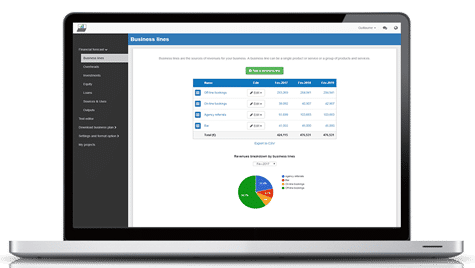How to create a financial forecast for a subscription box?
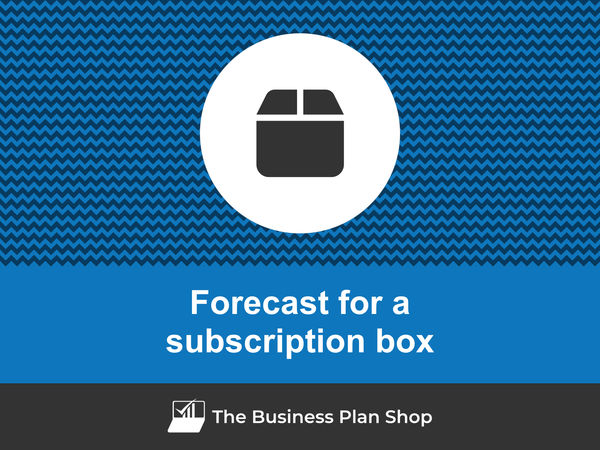
Creating a financial forecast for your subscription box, and ensuring it stays up to date, is the only way to maintain visibility on future cash flows.
This might sound complex, but with the right guidance and tools, creating an accurate financial forecast for your subscription box is not that hard.
In this guide, we'll cover everything from the main goal of a financial projection, the data you need as input, to the tables that compose it, and the tools that can help you build a forecast efficiently.
Without further ado, let us begin!
Why create and maintain a financial forecast for a subscription box?
The financial projections for your subscription box act as a financial blueprint to guide its growth with confidence and ensure its long-term financial viability.
To create them, you will need to look at your business in detail - from sales to operating costs and investments - to assess how much profit it can generate in the years to come and what will be the associated cash flows.
During challenging market conditions, maintaining an up-to-date financial forecast enables early detection of potential financial shortfalls, allowing for timely adjustments or securing financing before facing a cash crisis.
Your subscription box's financial forecast will also prove invaluable when seeking financing. Banks and investors will undoubtedly request a thorough examination of your financial figures, making precision and presentation essential.
Need a solid financial forecast?
The Business Plan Shop does the maths for you. Simply enter your revenues, costs and investments. Click save and our online tool builds a three-way forecast for you instantly.
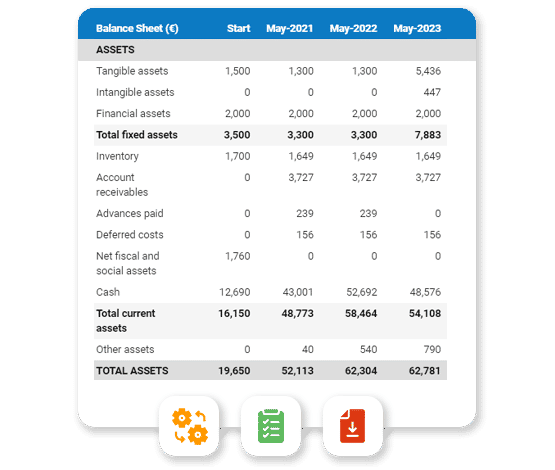
What information is used as input to build a subscription box financial forecast?
A subscription box's financial forecast needs to be built on the right foundation: your assumptions.
The data required to create your assumptions will depend on whether you are a new or existing subscription box.
If you are creating (or updating) the forecast of an existing subscription box, then your main inputs will be historical accounting data and operating metrics, and your team’s view on what to expect for the next three to five years.
If you are building financial projections for a new subscription box startup, you will need to rely on market research to form your go-to-market strategy and derive your sales forecast.
For a new venture, you will also need an itemised list of resources needed for the subscription box to operate, along with a list of equipment required to launch the venture (more on that below).
Now that you understand what is needed, let’s have a look at what elements will make up your subscription box's financial forecast.
The sales forecast for a subscription box
From experience, it usually makes sense to start your subscription box's financial projection with the revenues forecast.
The inputs used to forecast your sales will include the historical trading data of your subscription box (which can be used as a starting point for existing businesses) and the data collected in your market research (which both new ventures and existing businesses need to project their sales forward).
Your subscription box's sales forecast can be broken down into two key estimates:
- The average price
- The number of monthly transactions
To assess these variables accurately, you will need to consider the following factors:
- Product Quality: The quality of your subscription box's products can greatly affect the average price of your box. If you consistently provide high-quality items, you can justify raising your prices, which can increase your average price per box.
- Customer Retention: Retaining your current customers is crucial for maintaining a steady number of monthly transactions. By providing excellent customer service and consistently delivering valuable and exciting products, you can increase customer loyalty and retention.
- Competition: The level of competition in your specific niche can affect both your average price and the number of monthly transactions. If you face a lot of competition, you may need to lower your prices to remain competitive and attract more customers.
- Consumer Trends: Keeping up with current consumer trends can also impact your subscription box's average price and number of monthly transactions. If there is a sudden increase in demand for a particular type of product, you may need to adjust your offerings to meet this demand and potentially increase your prices.
- Product Variety: Offering a diverse range of products in your subscription box can attract a wider audience and potentially increase your average price. By including a mix of products at different price points, you can appeal to customers with varying budgets and preferences, leading to more monthly transactions.
Once you have a sales forecast in place, the next step will be to work on your overhead budget. Let’s have a look at that now.
Need inspiration for your business plan?
The Business Plan Shop has dozens of business plan templates that you can use to get a clear idea of what a complete business plan looks like.

The operating expenses for a subscription box
The next step is to estimate the costs you’ll have to incur to operate your subscription box.
These will vary based on where your business is located, and its overall size (level of sales, personnel, etc.).
But your subscription box's operating expenses should normally include the following items:
- Staff Costs: This includes salaries, benefits, and any other costs associated with hiring and retaining employees to run your subscription box business.
- Accountancy Fees: You will likely need the help of an accountant to manage your financial records, taxes, and other financial aspects of your subscription box business.
- Insurance Costs: It is important to have insurance coverage to protect your business, employees, and customers in case of any unforeseen events or accidents.
- Software Licenses: You may need to purchase software or pay for subscriptions to manage your inventory, shipping, and other aspects of your subscription box business.
- Banking Fees: You will likely incur fees for bank transfers, credit card processing, and other financial transactions related to your subscription box business.
- Packaging Materials: This includes boxes, tape, labels, and any other materials needed to package and ship your subscription box products to customers.
- Shipping Costs: You will need to factor in the cost of shipping your subscription boxes to customers, including both domestic and international shipping fees.
- Marketing and Advertising: It is important to invest in marketing and advertising to promote your subscription box business and attract new customers.
- Product Costs: This includes the cost of purchasing or creating the products that will be included in your subscription boxes.
- Customer Service: You may need to hire customer service representatives or outsource this task to manage inquiries, complaints, and other customer interactions related to your subscription box business.
- Rent/Utilities: If you have a physical location for your subscription box business, you will need to factor in the cost of rent and utilities such as electricity, water, and internet.
- Website Hosting and Maintenance: You will need to pay for website hosting and maintenance to keep your subscription box website up and running smoothly.
- Credit Card Processing Fees: When customers pay for their subscription boxes with credit cards, you will incur fees from credit card companies for processing those transactions.
- Professional Services: You may need to hire outside professionals for tasks such as graphic design, web development, or marketing to help grow your subscription box business.
- Inventory Management: If you have a large amount of inventory, you may need to invest in inventory management software or services to keep track of your products and ensure they are always in stock for your subscription boxes.
This list is not exhaustive by any means, and will need to be tailored to your subscription box's specific circumstances.
What investments are needed to start or grow a subscription box?
Creating and expanding a subscription box also requires investments which you need to factor into your financial forecast.
Capital expenditures and initial working capital items for a subscription box could include elements such as:
- Packaging Materials: As a subscription box business, you will need to invest in durable and attractive packaging materials to ensure that your products arrive safely to your customers. This can include boxes, bubble wrap, tissue paper, and other packaging supplies.
- Inventory Management Software: A subscription box business relies heavily on inventory management to ensure that you have enough products on hand to fulfill orders. Investing in a reliable inventory management software can help you keep track of your stock levels and prevent over or understocking.
- Shipping Supplies: In addition to packaging materials, you will also need to purchase shipping supplies such as labels, tape, and postage stamps. These supplies are essential for shipping out your subscription boxes to customers.
- Equipment and Tools: Depending on the type of products you include in your subscription box, you may need to invest in equipment and tools to assemble or customize your products. For example, if you include personalized items, you may need to purchase a printer or engraving machine.
- Warehouse or Storage Space: As your subscription box business grows, you may need to invest in additional warehouse or storage space to store your inventory. This can include renting a warehouse or purchasing storage shelves to keep your products organized and easily accessible.
Again, this list is not exhaustive and will need to be adjusted according to the circumstances of your subscription box.
Need a convincing business plan?
The Business Plan Shop makes it easy to create a financial forecast to assess the potential profitability of your projects, and write a business plan that’ll wow investors.
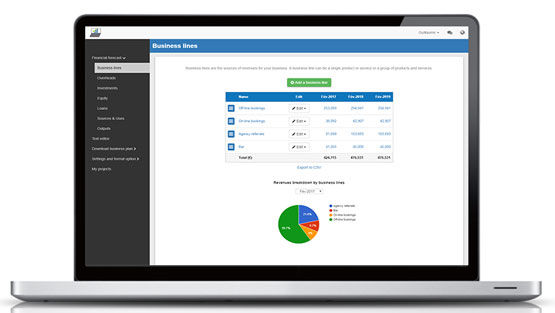
The financing plan of your subscription box
The next step in the creation of your financial forecast for your subscription box is to think about how you might finance your business.
You will have to assess how much capital will come from shareholders (equity) and how much can be secured through banks.
Bank loans will have to be modelled so that you can separate the interest expenses from the repayments of principal, and include all this data in your forecast.
Issuing share capital and obtaining a bank loan are two of the most common ways that entrepreneurs finance their businesses.
What tables compose the financial plan for a subscription box?
Now let's have a look at the main output tables of your subscription box's financial forecast.
The forecasted profit & loss statement
The profit & loss forecast gives you a clear picture of your business’ expected growth over the first three to five years, and whether it’s likely to be profitable or not.
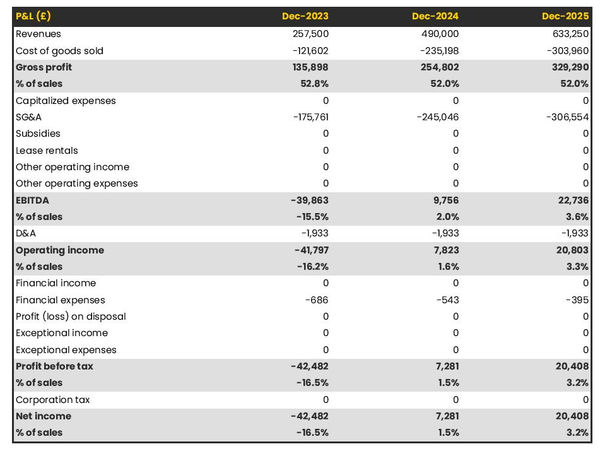
A healthy subscription box's P&L statement should show:
- Sales growing at (minimum) or above (better) inflation
- Stable (minimum) or expanding (better) profit margins
- A healthy level of net profitability
This will of course depend on the stage of your business: numbers for an established subscription box will look different than for a startup.
The projected balance sheet
The projected balance sheet gives an overview of your subscription box's financial structure at the end of the financial year.
It is composed of three categories of items: assets, liabilities and equity:
- Assets: are what the business possesses and uses to produce cash flows. It includes resources such as cash, buildings, equipment, and accounts receivable (money owed by clients).
- Liabilities: are the debts of your subscription box. They include accounts payable (money owed to suppliers), taxes due and bank loans.
- Equity: is the combination of what has been invested by the business owners and the cumulative profits to date (which are called retained earnings). Equity is a proxy for the value of the owner's stake in the business.
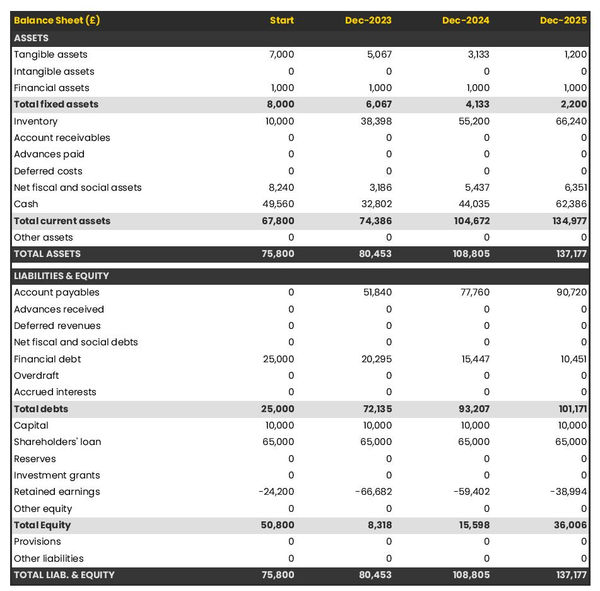
The cash flow projection
The cash flow forecast of your subscription box will show how much cash the business is expected to generate or consume over the next three to five years.

There are multiple ways of presenting a cash flow forecast but from experience, it is better to organise it by nature in order to clearly show these elements:
- Operating cash flow: how much cash is generated by the subscription box's operations
- Investing cash flow: what is the business investing to expand or maintain its equipment
- Financing cash flow: is the business raising additional funds or repaying financiers (debt repayment, dividends)
Your cash flow forecast is the most important element of your overall financial projection and that’s where you should focus your attention to ensure that your subscription box is adequately funded.
Note: if you are preparing a financial forecast in order to try to secure funding, you will need to include both a yearly and monthly cash flow forecast in your subscription box's financial plan.
Need a solid financial forecast?
The Business Plan Shop does the maths for you. Simply enter your revenues, costs and investments. Click save and our online tool builds a three-way forecast for you instantly.

Which tool should you use to create your subscription box's financial forecast?
Using the right tool or solution will make the creation of your subscription box's financial forecast much easier than it sounds. Let’s explore the main options.
Using online financial forecasting software to build your subscription box's projections
The modern and easiest way is to use professional online financial forecasting software such as the one we offer at The Business Plan Shop.
There are several advantages to using specialised software:
- You can easily create your financial forecast by letting the software take care of the financial calculations for you without errors
- You have access to complete financial forecast templates
- You get a complete financial forecast ready to be sent to your bank or investors
- You can easily track your actual financial performance against your financial forecast, and recalibrate your forecast as the year goes by
- You can create scenarios to stress test your forecast's main assumptions
- You can easily update your forecast as time goes by to maintain visibility on future cash flows
- You have a friendly support team on standby to assist you when you are stuck
- It’s cost-efficient and much cheaper than using an accountant or consultant (see below)
If you are interested in this type of solution, you can try our forecasting software for free by signing up here.
Calling in a financial consultant or chartered accountant
Enlisting the help of a consultant or accountant is also a good way to obtain a professional subscription box financial forecast.
The downside of this solution is its cost. From experience, obtaining a simple financial forecast over three years (including a balance sheet, income statement, and cash flow statement) is likely to cost a minimum of £700 or $1,000.
The indicative cost above, is for a small business, and a forecast is done as a one-shot exercise. Using a consultant or accountant to track your actuals vs. forecast and to keep your financial projections up to date on a monthly or quarterly basis will cost a lot more.
If you opt for this solution, make sure your accountant has in-depth knowledge of your industry, so that they may challenge your figures and offer insights (as opposed to just taking your assumptions at face value to create the forecast).
Why not use a spreadsheet such as Excel or Google Sheets to build your subscription box's financial forecast?
Creating an accurate and error-free subscription box financial forecast on Excel (or any spreadsheet) is very technical and requires both a strong grasp of accounting principles and solid skills in financial modelling.
Most entrepreneurs lack the expertise required to create an accurate financial forecast using spreadsheet software like Excel or Google Sheets. As a result, it is unlikely anyone will trust your numbers.
The second reason is that it is inefficient. Building forecasts on spreadsheets was the only option in the 1990s and early 2000s, nowadays technology has advanced and software can do it much faster and much more accurately.
This is why professional forecasters all use software. With the rise of AI, software is also becoming smarter at helping us detect mistakes in our forecasts and helping us analyse the numbers to make better decisions.
Finally, like everything with spreadsheets, tracking actuals vs. forecasts and updating your forecast as the year progresses is manual, tedious, error-prone, and time-consuming. Whereas financial forecasting software like The Business Plan Shop is built for this.
Need a convincing business plan?
The Business Plan Shop makes it easy to create a financial forecast to assess the potential profitability of your projects, and write a business plan that’ll wow investors.

Use our financial forecast templates for inspiration
The Business Plan Shop has dozens of financial forecast examples available.
Our templates contain both a financial forecast and a written business plan which presents, in detail, the company, the team, the strategy, and the medium-term objectives.
Our templates are a great source of inspiration, whether you just want to see what a complete business plan looks like, or are looking for concrete examples of how you should model financial elements in your own forecast.
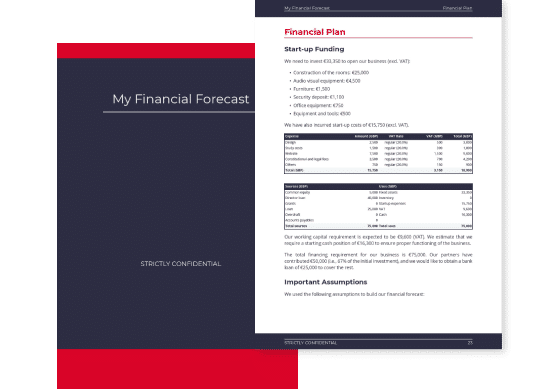
Takeaways
- Having a financial forecast enables you to visualise the expected growth, profitability, and cash generation for your business over the next three to five years.
- Tracking actuals vs. forecast and keeping your financial projections up-to-date is the only way to get a view on what your subscription box future cash flows may look like.
- Using financial forecasting software is the mordern and easy way to create and maintain your forecasts.
This is the end of our guide on how to build the financial forecast for a subscription box, we hope you found it useful. Don't hesitate to contact us if you want to share your feedback or have any questions.
Need inspiration for your business plan?
The Business Plan Shop has dozens of business plan templates that you can use to get a clear idea of what a complete business plan looks like.

Also on The Business Plan Shop
Know someone who owns or is thinking of starting a subscription box? Share our forecasting guide with them!

